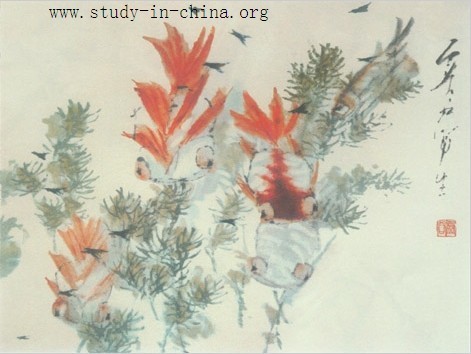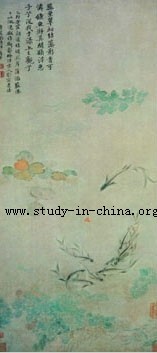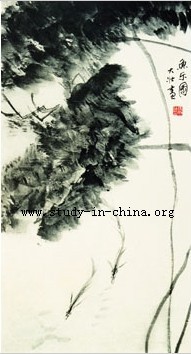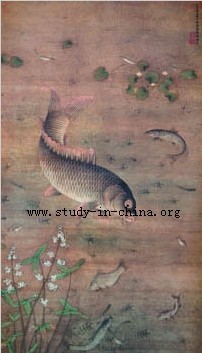more>>More News
- National Day
- ways to integrate into Chinese style life
- Should they be in the same university with me?!!
- Chinese Ping Pang Legend: the Sun Will Never Set
- A Glance of those Funny University Associations
- mahjong----The game of a brand new sexy
- Magpie Festival
- Park Shares Zongzi for Dragon Boat Festival
- Yue Fei —— Great Hero
- Mei Lanfang——Master of Peking Opera
Chinese Fish Paintings
By admin on 2015-02-02
The words for fish and abundance are pronounced the same in Chinese (鱼,yu) so the fish in the Chinese culture symbolizes wealth. Fish also symbolize harmony, marital happiness and reproduction because they multiply rapidly and sometimes swim in pairs. Chinese legend says people placed messages in the bellies of the fish, and thus the fish has come to symbolize communication with a distant friend or loved one. Fish is an important symbol in the Buddhist religion and are among the auspicious signs on the Footprints of Buddha. The fish on the Buddha footprints signifies freedom from all restraints. The most popular fish motif found in Chinese art and culture is that of the Carp or Koi fish. Known to most Westerners as Koi Fish, the Chinese carp has numerous symbolic values within Chinese culture. The carp is a powerful symbol of strength and perseverance. The scales and whiskers of the carp resemble that of a dragon, a great symbol of power in China. At the New Year Festival "lucky money" is given out in red envelopes decorated with a carp and symbols of long life such as peach and pine trees. The word "koi" comes from the Japanese word meaning “carp”. Koi fish have many different colors with the major colors being black, white, red, yellow, and cream colored.

Fallen Petals and
Goldfish
Xu Gu
Ink and color on paper
34.7*40.6 cm
Shanghai
Museum
In this painting, four goldfish sink to the bottom among green algai in the clear water. Two fish have their backs toward the vewer and the other two have their underside shown. Although the agility of real life goldfish is absent and the artist disregards the customary taboo against showing the underside of fish in paintings, the simple, na?ve charm of the goldfish stands out.

Fallen Flowers and
Swimming Fish
Yun Shouping, Qing Dynasty
Ink and color on
paper
65.5*30.1cm
"You are not fish, how would you know the happiness of fish?" Chuang Tsu (369-286 BC) uttered this famous saying when he discussed an issue with Hui Tsu. The moral of the story is that others have their own enjoyment that others cannot appreciate. Yun Shouping liked to paint aquatic lives on this theme. In this work, fallen peach flowers attract a school of fish chasing after them. The fish are beautiful, free and relaxed. Duckweeds and algae are half-visible, providing enough space for the activities of fish. The application of "boneless" techniques makes the swimming fish more real and convincing. The technique of painting flowers and birds from life was already quite sophisticated in the two Song periods and it became further developed in the hands of Yun Shouping.

Happy Fish by Zhang
Dazhuang
Ink on paper
Shanghai Academy of Chinese
Painting
Zhang Dazhuang (1903-1980)
Courtesy
name: Yanglu; native of Hangzhou, Zhejiang Province; nephew of Zhang Taiyan. He
was in charge of calligraphic works and paintings in the collection of the
collector Pang Laichen. He specialized in flower-and-bird painting, in the
tradition of Yun Shouping (1633-1690) but with innovations in subject matter and
techniques. With the founding of the PRC, he was appointed painter at Shanghai
Academy of Chinese Painting. This painting depicts a lotus leaf big as an
umbrella occupying the upper half of the picture surface, with a flower
partially revealed and a wiggly, lightly inked line extending from top to
bottom, meant to be the stem. Three fish swimming under the flower enliven the
painting and give the theme of "Happy Fish." Two horizontal lines entering the
picture from the right must be a continuation of the two lotus stems at bottom,
which is in obvious contradiction with the natural ways of the lotus but
necessary for compositional balance. Note the artist's successful use of ink
left standing overnight, which contains particulates, to model the broken lotus
leaves.

Fish and
Algae
Miao Fu, Ming Dynasty
Ink and color on
silk
171.3*99.1cm
In this picture, a gigantic carp shakes
its head and wags its tail in the water, relaxed and pleased with itself,
looking down on the bream, crucian carp, perch and catfish. The carp is
considered the incarnation of the dragon in folklore, and brings bliss and
wealth to people. The painter makes this carp the king of the water. In fact, he
is eulogizing the emperor's nobility and generosity in a subtle way. What more
would one expect of a court painter?
- Contact Us
-
Tel:
0086-571-88165708
0086-571-88165512E-mail:
admission@cuecc.com
- About Us
- Who We Are What we do Why CUECC How to Apply
- Address
- Study in China TESOL in China
Hangzhou Jiaoyu Science and Technology Co.LTD.
Copyright 2003-2024, All rights reserved




 Chinese
Chinese
 English
English
 Korean
Korean
 Japanese
Japanese
 French
French
 Russian
Russian
 Vietnamese
Vietnamese
